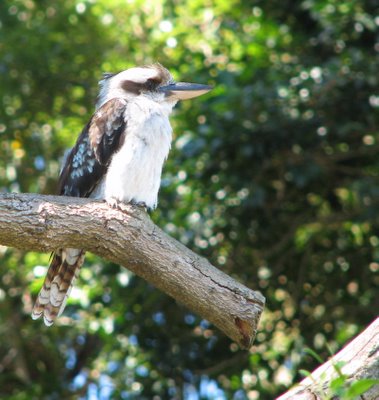Taronga Zoological Park
Above: Photo of the entrance to Taronga Zoological Park, Sydney.
We are in Sydney visiting our son and daughter in law. Today we went to the Taronga Zoological Park. it has been almost six years since our last visit. There have been many changes made since then. It was quite obvious that big attempts have been made to improve both the animal displays and the overall facilities for humans.
While our prime objective was to view the animal displays, I cannot help being on the lookout for native Australian birds flying around free. Many of the enclosure’s feed trays provide a free meal for some of our native species. This Noisy Miner didn’t need to get into one of the cages. It just fed from a bottlebrush flower poking though one of the aviaries.

Above: Photo of Noisy Miner feeding on a bottlebrush (Callistemon sp)
As we were going along we observed a Laughing Kookaburra sitting quietly on the branch of a tree near the path. This is one species I have been trying to photograph since buying my new digital camera. This was one species I didn’t expect to see or photograph today.

Above: Photo of a Laughing Kookaburra in the grounds of Taronga Zoo, Sydney.
One of the highlights of visiting Taronga Zoo is the show put on by a range of Australian birds under the direction of several keepers. It is awesome to observe a Wedge Tailed Eagle gliding about a metre or two overhead as it headed down towards the keeper. We also saw a beautiful White-Bellied Sea-Eagle. 
Above: Photo of a White-Bellied Sea-Eagle
Lorikeets, Parrots and Wattlebirds
This evening I was attracted by some birds calling outside. I went to investigate, thinking that they were probably Rainbow Lorikeets. I didn’t take my camera with me.
Sure enough, I had some good views of two Rainbow Lorikeets in the tree next to our driveway. The seeting sun was lighting up the brilliant colours of one of them. I needed my camera. It was still inside.
I casually walked inside trying not to scare the birds away by sudden movements. On emerging with the camera the lorikeets had disappeared – of course! Instead, I was content to get some very good shots of a Red Wattlebird in the setting sun in the same tree. It almost seemed like he was posing for me.
Perhaps the lorikeets had persuaded him to pose for them, because as I walked inside, they emerged from a nearby tree and flew a sortie overhead, screeching their taunts at me. One day, one day I’ll get a good shot of them.
Rainbow Lorikeets are quite common throughout the urban areas of Murray Bridge but we only occasionally see them on our home block on the outskirts of the city. In recent weeks they have been daily visitors. This indicates that there has to be enough plants flowering around here to attract these beautiful, but noisy, birds.
On this morning’s walk a had good views of two Elegant Parrots. This beautiful species is widespread in this area but they are not common anywhere. I also saw a single Adelaide Rosella. These are common in the Adelaide region and this is the eastern extent of their range and are uncommon in Murray Bridge. If I’d had my camera with me I would have been able to get an excellent photograph of a Rainbow Bee-eater sitting on a gate in the early morning sun.
Tomorrow.
Tomorrow – I’ll take my camera on my walk.
Gluepot Bird Sanctuary – more photographs
I’ve just been editing some of the photographs I took on my recent visit to Gluepot Bird Sanctuary near Waikerie in South Australia.
Yellow Plumed Honeyeater
Yellow Plumed Honeyeaters seemed to be almost everywhere, and very common wherever the mallee was in flower.
Chestnut Quail-Thrush
The striking plumage makes for excellent camouflage, but this individual was quite obvious on the bare earth.
New Holland Honeyeaters
New Holland Honeyeaters are a common Australian bird, especially in parks and gardens. Good views of them can be easily had as they flit to and fro from bush to bush. Sometimes they even sit still enough for good views of their beautiful markings. On rare occasions they even sit long enough to capture a photograph!
This stunning photograph was taken a few days ago while looking over our neighbour’s fence. The bird posed long enough for me to take several shots. The green object it is perched on is the handle of a small hand operated plough. Our neighbour has several old farm implements in his front garden.
Over the years I have been interested in the occurrence of New Holland Honeyeaters in our garden. They are probably the most numerous and widespread species of honeyeater in the Murray Bridge region. In the first 15 years of us living here they were only occasional visitors to our garden and patch of mallee scrub. I have kept monthly records of all birds seen on our property since January 1985. My database of bird observations (BirdInfo – which is no longer available) shows a sudden increase of observations in late 1998. From that time to the present New Holland Honeyeaters have been the predominant honeyeater species here.
Other species of honeyeaters recorded here include:
Red Wattlebird: resident, breeding species.
White Plumed Honeyeater (resident, breeding)
Spiny Cheeked Honeyeater (resident, breeding)
Striped Honeyeater (occasional visitor, one breeding record)
White-Eared Honeyeater (occasional visitor)
Yellow Plumed Honeyeater (occasional visitor)
Singing Honeyeater (resident, breeding)
Brown-Headed Honeyeater (resident, breeding).
You can find photos of many of these honeyeater species, including photos, by searching on this site, or clicking on the species name (not all have links).
One possible explanation of this change is the maturing of many of the native Australian plants we have planted over the years. Our property is now far more bird welcoming than, say 15 years ago.
Update: this post was updated on November 5th, 2013.





